-

新人教版高中英语选修2Unit 3 Using langauge-Listening教学设计
1. How is Hunan cuisine somewhat different from Sichuan cuisine?The heat in Sichuan cuisine comes from chilies and Sichuan peppercorns. Human cuisine is often hotter and the heat comes from just chilies.2.What are the reasons why Hunan people like spicy food?Because they are a bold people. But many Chinese people think that hot food helps them overcome the effects of rainy or wet weather.3.Why do so many people love steamed fish head covered with chilies?People love it because the meat is quite tender and there are very few small bones.4.Why does Tingting recommend bridge tofu instead of dry pot duck with golden buns?Because bridge tofu has a lighter taste.5 .Why is red braised pork the most famous dish?Because Chairman Mao was from Hunan, and this was his favorite food.Step 5: Instruct students to make a short presentation to the class about your choice. Use the example and useful phrases below to help them.? In groups of three, discuss what types of restaurant you would like to take a foreign visitor to, and why. Then take turns role-playing taking your foreign guest to the restaurant you have chosen. One of you should act as the foreign guest, one as the Chinese host, and one as the waiter or waitress. You may start like this:? EXAMPLE? A: I really love spicy food, so what dish would you recommend?? B: I suggest Mapo tofu.? A: Really ? what's that?

新人教版高中英语选修2Unit 4 Reading for writing教学设计
假定你是英国的Jack,打算来中国旅行,请你给你的中国笔友李华写一封信,要点如下:1.你的旅行计划:北京→泰山→杭州;2.征求建议并询问他是否愿意充当你的导游。注意:1.词数80左右(开头和结尾已给出,不计入总词数);2.可以适当增加细节,以使行文连贯。参考词汇:故宫 the Forbidden City;泰山 Mount TaiDear Li Hua,I'm glad to tell you that 'm going to visit China.First,I am planning to visit Beijing,the capitalof China,where I am looking forward to enjoying the Great Wall,the Forbidden City and somebeautiful parks.Then I intend to go to visit Mount Tai in Shandong Province.I've heard that it is one ofthe most famous mountains in China and I can't wait to enjoy the amazing sunrise there.After that,I amalso going to Hangzhou.It is said that it is a beautiful modern city with breathtaking natural sights,among which the West Lake is a well- known tourist attraction.What do you think of my travel plan? Will you act as my guide? Hope to hear from you soon.

新人教版高中英语选修2Unit 4 Using langauge-Listening教学设计
The theme of the listening section is " talking about scenery and culture along a journey."The part is designed to further lead the students to understand Canadian natural geography and social environment, and integrated into the cultural contrast by mentioning the long train journey from Beijing to Moscow routes. On this basis, the part activates students related travel experience, lets the student serial dialogue, guides the student to explore further the pleasure and meaning of the long journey, and Chinese and foreign cultural comparison.The part also provides a framework for the continuation of the dialogue, which is designed to provide a framework for students to successfully complete their oral expressions, and to incorporate an important trading strategy to end the dialogue naturally.1. Help students to understand and master some common English idioms in the context, and experience the expression effect of English idioms.2. Guide the students to understand the identity of different people in the listening context, and finish the dialogue according to their own experience.3. Instruct the students to use appropriate language to express surprise and curiosity about space and place in the dialogue, and master the oral strategy of ending the dialogue naturally.1. Instruct students to grasp the key information and important details of the dialogue.2. Instruct students to conduct a similar talk on the relevant topic.

新人教版高中英语选修2Unit 5 Learning about Language教学设计
The purpose of this section of vocabulary exercises is to consolidate the key words in the first part of the reading text, let the students write the words according to the English definition, and focus on the detection of the meaning and spelling of the new words. The teaching design includes use English definition to explain words, which is conducive to improving students' interest in vocabulary learning, cultivating their sense of English language and thinking in English, and making students willing to use this method to better grasp the meaning of words, expand their vocabulary, and improve their ability of vocabulary application. Besides, the design offers more context including sentences and short passage for students to practice words flexibly.1. Guide students to understand and consolidate the meaning and usage of the vocabulary in the context, 2. Guide the students to use the unit topic vocabulary in a richer context3. Let the students sort out and accumulate the accumulated vocabulary, establishes the semantic connection between the vocabulary,4. Enable students to understand and master the vocabulary more effectivelyGuiding the Ss to use unit topic words and the sentence patterns in a richer context.Step1: Read the passage about chemical burns and fill in the blanks with the correct forms of the words in the box.

新人教版高中英语选修2Unit 5 Reading and thinking教学设计
The theme of this activity is to learn the first aid knowledge of burns. Burns is common in life, but there are some misunderstandings in manual treatment. This activity provides students with correct first aid methods, so as not to take them for granted in an emergency. This section guides students to analyze the causes of scald and help students avoid such things. From the perspective of text structure and collaborative features, the text is expository. Expository, with explanation as the main way of expression, transmits knowledge and information to readers by analyzing concepts and elaborating examples. This text arranges the information in logical order, clearly presents three parts of the content through the subtitle, accurately describes the causes, types, characteristics and first aid measures of burns, and some paragraphs use topic sentences to summarize the main idea, and the level is very clear.1. Guide students to understand the causes, types, characteristics and first aid methods of burns, through reading2. Enhance students’ ability to deal withburnss and their awareness of burns prevention3. Enable students to improve the ability to judge the types of texts accurately and to master the characteristics and writing techniques of expository texts.Guide students to understand the causes, types, characteristics and first aid methods of burns, through readingStep1: Lead in by discussing the related topic:1. What first-aid techniques do you know of ?CPR; mouth to mouth artificial respiration; the Heimlich Manoeuvre

新人教版高中英语选修2Unit 5 Using langauge-Listening教学设计
The theme of this section is to learn how to make emergency calls. Students should learn how to make emergency calls not only in China, but also in foreign countries in English, so that they can be prepared for future situations outside the home.The emergency telephone number is a vital hotline, which should be the most clear, rapid and effective communication with the acute operator.This section helps students to understand the emergency calls in some countries and the precautions for making emergency calls. Through the study of this section, students can accumulate common expressions and sentence patterns in this context. 1.Help students accumulate emergency telephone numbers in different countries and learn more about first aid2.Guide the students to understand the contents and instructions of the telephone, grasp the characteristics of the emergency telephone and the requirements of the emergency telephone.3.Guide students to understand the first aid instructions of the operators.4.Enable Ss to make simulated emergency calls with their partners in the language they have learned1. Instruct students to grasp the key information and important details of the dialogue.2. Instruct students to conduct a similar talk on the relevant topic.Step1:Look and discuss:Match the pictures below to the medical emergencies, and then discuss the questions in groups.
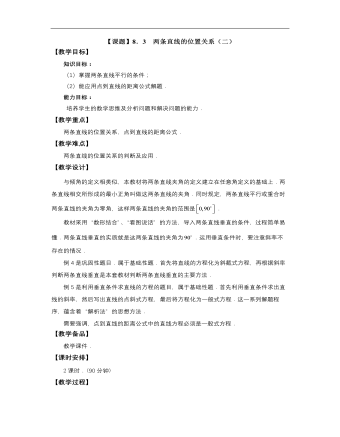
高教版中职数学基础模块下册:8.3《两条直线的位置关系》教案设计
教 学 过 程教师 行为学生 行为教学 意图 *揭示课题 8.3 两条直线的位置关系(二) *创设情境 兴趣导入 【问题】 平面内两条既不重合又不平行的直线肯定相交.如何求交点的坐标呢? 图8-12 介绍 质疑 引导 分析 了解 思考 启发 学生思考 *动脑思考 探索新知 如图8-12所示,两条相交直线的交点,既在上,又在上.所以的坐标是两条直线的方程的公共解.因此解两条直线的方程所组成的方程组,就可以得到两条直线交点的坐标. 观察图8-13,直线、相交于点P,如果不研究终边相同的角,共形成四个正角,分别为、、、,其中与,与为对顶角,而且. 图8-13 我们把两条直线相交所成的最小正角叫做这两条直线的夹角,记作. 规定,当两条直线平行或重合时,两条直线的夹角为零角,因此,两条直线夹角的取值范围为. 显然,在图8-13中,(或)是直线、的夹角,即. 当直线与直线的夹角为直角时称直线与直线垂直,记做.观察图8-14,显然,平行于轴的直线与平行于轴的直线垂直,即斜率为零的直线与斜率不存在的直线垂直. 图8-14 讲解 说明 讲解 说明 引领 分析 仔细 分析 讲解 关键 词语 思考 思考 理解 思考 理解 记忆 带领 学生 分析 带领 学生 分析 引导 式启 发学 生得 出结 果
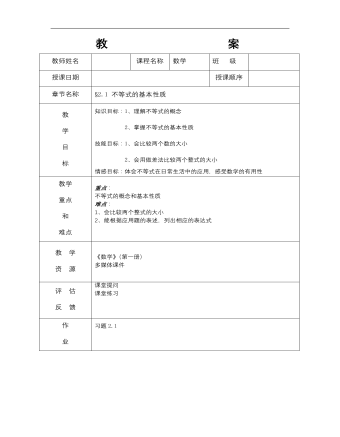
【高教版】中职数学基础模块上册:2.1《不等式的基本性质》教案设计
教师姓名 课程名称数学班 级 授课日期 授课顺序 章节名称§2.1 不等式的基本性质教 学 目 标知识目标:1、理解不等式的概念 2、掌握不等式的基本性质 技能目标:1、会比较两个数的大小 2、会用做差法比较两个整式的大小 情感目标:体会不等式在日常生活中的应用,感受数学的有用性教学 重点 和 难点 重点: 不等式的概念和基本性质 难点: 1、会比较两个整式的大小 2、能根据应用题的表述,列出相应的表达式教 学 资 源《数学》(第一册) 多媒体课件评 估 反 馈课堂提问 课堂练习作 业习题2.1课后记
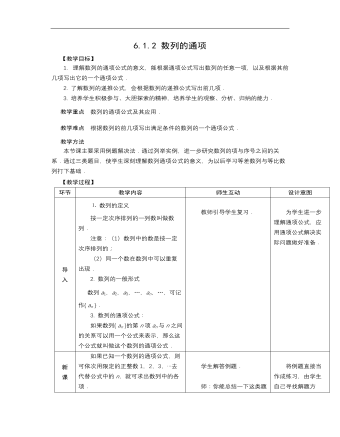
高教版中职数学基础模块下册:6.1《数列的概念》教案设计
【教学目标】1. 理解数列的通项公式的意义,能根据通项公式写出数列的任意一项,以及根据其前几项写出它的一个通项公式.2. 了解数列的递推公式,会根据数列的递推公式写出前几项.3.培养学生积极参与、大胆探索的精神,培养学生的观察、分析、归纳的能力.教学重点 数列的通项公式及其应用.教学难点 根据数列的前几项写出满足条件的数列的一个通项公式.教学方法 本节课主要采用例题解决法.通过列举实例,进一步研究数列的项与序号之间的关系.通过三类题目,使学生深刻理解数列通项公式的意义,为以后学习等差数列与等比数列打下基础.【教学过程】 环节教学内容师生互动设计意图导 入⒈数列的定义 按一定次序排列的一列数叫做数列. 注意:(1)数列中的数是按一定次序排列的; (2)同一个数在数列中可以重复出现. 2. 数列的一般形式 数列a1,a2,a3,…,an,…,可记作{ an }. 3. 数列的通项公式: 如果数列{ an }的第n项an与n之间的关系可以用一个公式来表示,那么这个公式就叫做这个数列的通项公式. 教师引导学生复习. 为学生进一步理解通项公式,应用通项公式解决实际问题做好准备.
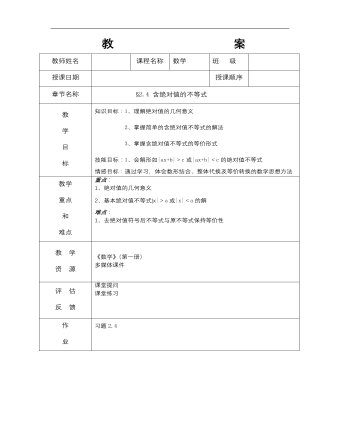
【高教版】中职数学基础模块上册:2.4《含绝对值的不等式》教案设计
教师姓名 课程名称数学班 级 授课日期 授课顺序 章节名称§2.4 含绝对值的不等式教 学 目 标知识目标:1、理解绝对值的几何意义 2、掌握简单的含绝对值不等式的解法 3、掌握含绝对值不等式的等价形式 技能目标:1、会解形如|ax+b|>c或|ax+b|<c的绝对值不等式 情感目标:通过学习,体会数形结合、整体代换及等价转换的数学思想方法教学 重点 和 难点重点: 1、绝对值的几何意义 2、基本绝对值不等式|x|>a或|x|<a的解 难点: 1、去绝对值符号后不等式与原不等式保持等价性教 学 资 源《数学》(第一册) 多媒体课件评 估 反 馈课堂提问 课堂练习作 业习题2.4课后记不等式的基本性质是初中就学习过的内容,分式不等式的解法是哦本节课的一个重点和难点,尤其是不等号另一边不为0的情况,需要移项,这一点在强调前学生考虑不到,因此解题错误多。区间是个新内容,学生往往将连续的正数写作一个区间,这是常见的错误,要进行提醒。另外,在均值不等式这里稍微补充了一些内容,引起学生的兴趣。
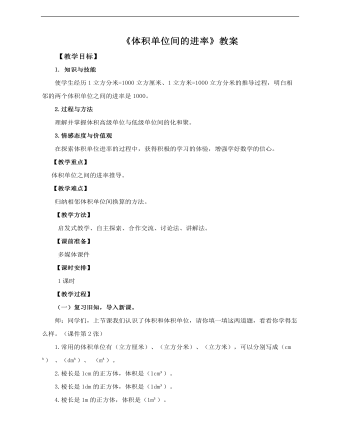
小学数学人教版五年级下册《第六课体积单位间的进率》教案说课稿
(一)复习旧知,导入新课。师:同学们,上节课我们认识了体积和体积单位,请你填一填这两道题,看看你学得怎么样。(课件第2张)1.常用的体积单位有(立方厘米)、(立方分米)、(立方米),可以分别写成(cm³) 、(dm³)、 (m³)。2.棱长是1cm的正方体,体积是(1cm³)。3.棱长是1dm的正方体,体积是(1dm³)。4.棱长是1m的正方体,体积是(1m³)。【设计意图】1dm³是多少cm³呢?这节课我们就来研究一下体积单位间的进率。(板书课题)(二)探究新知1.探究立方分米和立方厘米间的进率:(课件第3张)(1)下图是一个棱长为1dm的正方体,体积是1dm³。想一想,它的体积是多少立方厘米呢?(2)小组讨论,你是怎样想的?(3)汇报交流:(课件第4张)生1:如果把它的棱长看作是10cm,可以把它切成1000块1cm³的小正方体。10×10×10=1000.生2:它的底面积是1dm²,就是100cm²,100×10=1000,一共是1000cm³。1dm³=1000cm³【设计意图】用小组讨论的方式,让学生从讨论的过程中找到解决问题的方法,培养学生的语言表达能力、思维能力。2.你知道1m³等于多少立方分米吗?(课件第5张)生1:把棱长是1m的正方体,看作棱长是10dm的正方体,10×10×10=1000dm³。1m³=1000dm³。 生2:棱长是1m的正方体,底面积是1m²,就是100dm²,100×10=1000dm³,一共是1000dm³。生3:1m³=1000dm³ 3.整理计量单位之间的进率。(1)小组讨论:到现在为止,我们已经学习了哪些计量单位?请整理在表中。

小学数学北师大版二年级上册《第一课谁的得分高》教案说课稿
2.过程与方法经历与他人交流算法的过程,能有条理地叙述自己的思考过程,能计算100以内数的连加运算。3.情感态度和价值观在计算过程中初步养成认真、细心、耐心检查的良好学习习惯。【教学重点】 会分析数量关系,并计算100以内数的加法。【教学难点】 运用100以内数的加法解决简单的实际问题。【教学方法】 合作、探究、交流【课前准备】 多媒体课件【课时安排】 1课时【教学过程】一、创设情境、引出问题1.出示情境图:同学们,你们喜欢套圈游戏吗?你们看,淘气和笑笑也来参加好玩的套圈游戏,让我们一起来看一看。这个游戏是怎么玩的,你看懂了吗?从每个小动物前面的得分我们知道离淘气和笑笑越远的小动物套中后得分越高。而且机灵狗告诉我们规则是“每人投3次,每套中的得0分,总分高的获胜”。判断胜负,有时不光要看胜的场次,还要看什么?分数,分高者胜。要引导学生明白得分是根据图中套中的小动物得到的。机灵狗说的是什么意思,谁听懂了?2.引导学生有序观察图意,并让学生看图说一说:从图中你知道哪些数学信息?
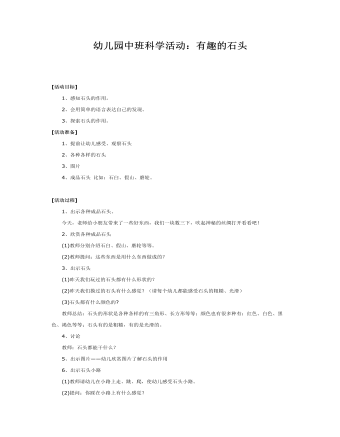
幼儿园中班科学教案:有趣的石头
2、会用简单的语言表达自己的发现。3、探索石头的作用。[活动准备]1、提前让幼儿感受、观察石头2、各种各样的石头3、图片4、成品石头比如:石臼、假山、磨轮。 [活动过程]1、出示各种成品石头。 今天,老师给小朋友带来了一些好东西,我们一块数三下,吹起神秘的丝绸打开看看吧!2、欣赏各种成品石头
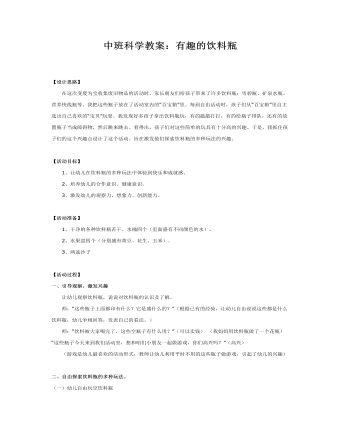
中班科学教案:有趣的饮料瓶
【活动目标】1、让幼儿在饮料瓶的多种玩法中体验到快乐和成就感。2、培养幼儿的合作意识、健康意识。3、激发幼儿的观察力、想象力、创新能力。 【活动准备】1、干净的各种饮料瓶若干、水桶四个(里面盛有不同颜色的水)。2、水果盘四个(分别盛有黄豆、花生、玉米)。3、两盆沙子 【活动过程】一、引导观察,激发兴趣 让幼儿观察饮料瓶,说说对饮料瓶的认识及了解。 师:“这些瓶子上面都印有什么?它是盛什么的?”(根据已有的经验,让幼儿自由说说这些都是什么饮料瓶,幼儿争相回答,发表自己的看法。) 师:“饮料被大家喝完了,这些空瓶子有什么用?”(可以卖钱)(我妈妈用饮料瓶做了一个花瓶)“这些瓶子今天来到我们活动室,想和咱们小朋友一起做游戏,你们高兴吗?”(高兴) (游戏是幼儿最喜欢的活动形式,教师让幼儿利用平时不用的这些瓶子做游戏,引起了幼儿的兴趣)
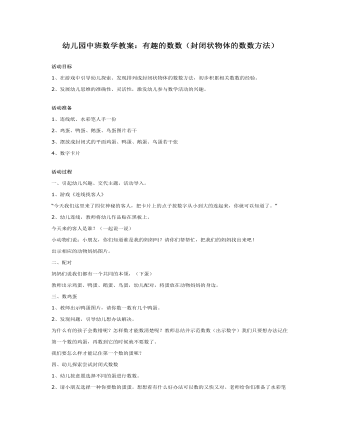
幼儿园中班数学教案:有趣的数数
2、发展幼儿思维的准确性、灵活性,激发幼儿参与数学活动的兴趣。 活动准备 1、连线纸、水彩笔人手一份 2、鸡蛋、鸭蛋、鹅蛋、鸟蛋图片若干 3、摆放成封闭式的平面鸡蛋、鸭蛋、鹅蛋、鸟蛋若干张 4、数字卡片 活动过程 一、引起幼儿兴趣、交代主题,活动导入。 1、游戏《连线找客人》 “今天我们这里来了四位神秘的客人,把卡片上的点子按数字从小到大的连起来,你就可以知道了。” 2、幼儿连线,教师将幼儿作品贴在黑板上。 今天来的客人是谁?(一起说一说) 小动物们说:小朋友,你们知道谁是我的妈妈吗?请你们帮帮忙,把我们的妈妈找出来吧! 出示相应的动物妈妈图片。
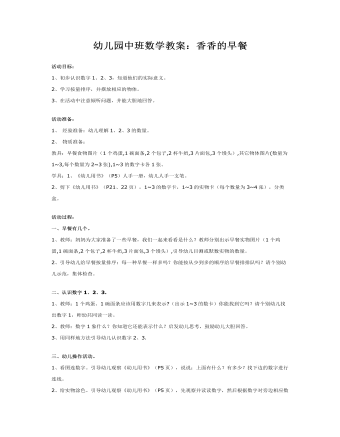
幼儿园中班数学教案:香香的早餐
2、学习按量排序,并摆放相应的物体。 3、在活动中注意倾听问题,并能大胆地回答。 活动准备: 1、经验准备:幼儿理解1、2、3的数量。 2、物质准备: 教具:早餐食物图片(1个鸡蛋,1碗面条,2个包子,2杯牛奶,3片面包,3个馒头),其它物体图片(数量为1~3,每个数量为2~3张),1~3的数字卡各1张。 学具:1、《幼儿用书》(P5)人手一册,幼儿人手一支笔。 2、剪下《幼儿用书》(P21、22页),1~3的数字卡,1~3的实物卡(每个数量为3~4张),分类盒。 活动过程: 一、早餐有几个。 1、教师:妈妈为大家准备了一些早餐,我们一起来看看是什么?教师分别出示早餐实物图片(1个鸡蛋,1碗面条,2个包子,2杯牛奶,3片面包,3个馒头),引导幼儿目测或默数实物的数量。 2、引导幼儿给早餐按量排序:每一种早餐一样多吗?你能按从少到多的顺序给早餐排排队吗?请个别幼儿示范,集体检查。
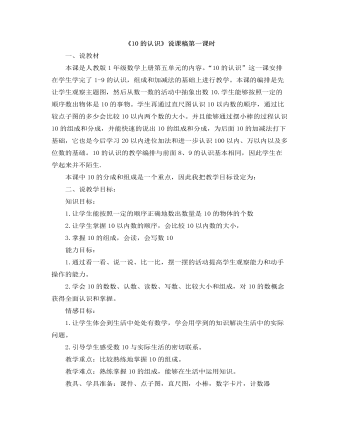
小学数学人教版一年级上册《10的认识》说课稿第一课时
一、说教材本课是人教版1年级数学上册第五单元的内容。“10的认识”这一课安排在学生学完了1-9的认识,组成和加减法的基础上进行教学。本课的编排是先让学生观察主题图,然后从数一数的活动中抽象出数10.学生能够按照一定的顺序数出物体是10的事物。学生再通过直尺图认识10以内数的顺序,通过比较点子图的多少会比较10以内两个数的大小。并且能够通过摆小棒的过程认识10的组成和分成,并能快速的说出10的组成和分成,为后面10的加减法打下基础,它也是今后学习20以内进位加法和进一步认识100以内、万以内以及多位数的基础。10的认识的教学编排与前面8、9的认识基本相同,因此学生在学起来并不陌生.本课中10的分成和组成是一个重点,因此我把教学目标设定为:
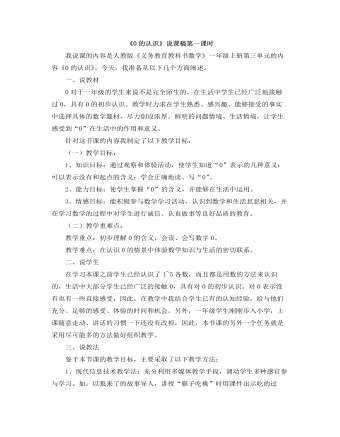
小学数学人教版一年级上册《0的认识》说课稿第一课时
一、说教材 0对于一年级的学生来说不是完全陌生的,在生活中学生已经广泛地接触过0,具有0的初步认识。教学时力求在学生熟悉、感兴趣、能够接受的事实中选择具体的数学题材,尽力创设浓厚、鲜明的问题情境、生活情境,让学生感受到“0”在生活中的作用和意义。针对这节课的内容我制定了以下教学目标: (一)教学目标: 1、知识目标:通过观察和体验活动,使学生知道“0”表示的几种意义:可以表示没有和起点的含义;学会正确地读、写“0”。 2、能力目标:使学生掌握“0”的含义,并能够在生活中运用。 3、情感目标:能积极参与数学学习活动,认识到数学和生活息息相关,并在学习数学的过程中对学生进行诚信、认真做事等良好品质的教育。 (二)教学重难点: 教学重点:初步理解0的含义,会读、会写数字0。 教学难点:在认识0的情景中体验数学知识与生活的密切联系。
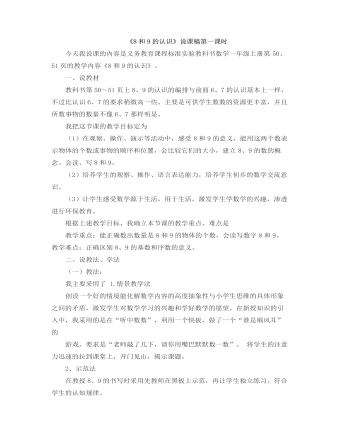
小学数学人教版一年级上册《8和9的认识》说课稿第一课时
今天我说课的内容是义务教育课程标准实验教科书数学一年级上册第50、51页的教学内容《8和9的认识》。一、说教材教科书第50~51页上8、9的认识的编排与前面6、7的认识基本上一样,不过比认识6、7的要求稍微高一些。主要是可供学生数数的资源更丰富,并且所数事物的数量不像6、7那样明显。我把这节课的教学目标定为(1)在观察、操作、演示等活动中,感受8和9的意义,能用这两个数表示物体的个数或事物的顺序和位置,会比较它们的大小,建立8、9的数的概念。会读、写8和9。(2)培养学生的观察、操作、语言表达能力,培养学生初步的数学交流意识。(3)让学生感受数学源于生活,用于生活,激发学生学数学的兴趣,渗透进行环保教育。根据上述教学目标,我确立本节课的教学重点、难点是教学重点:能正确数出数量是8和9的物体的个数,会读写数字8和9。 教学难点:正确区别8、9的基数和序数的意义。
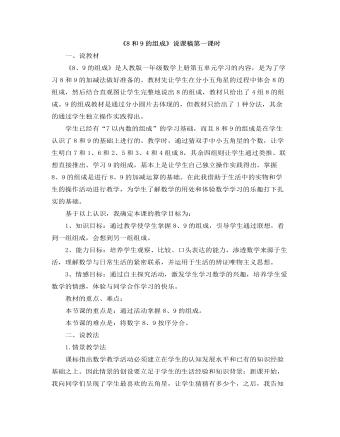
小学数学人教版一年级上册《8和9的组成》说课稿第一课时
一、说教材《8、9的组成》是人教版一年级数学上册第五单元学习的内容,是为了学习8和9的加减法做好准备的。教材先让学生在分小五角星的过程中体会8的组成,然后结合直观图让学生完整地说出8的组成,教材只给出了4组8的组成。9的组成教材是通过分小圆片去体现的,但教材只给出了1种分法,其余的通过学生独立操作实践得出。学生已经有“7以内数的组成”的学习基础,而且8和9的组成是在学生认识了8和9的基础上进行的。教学时,通过猜双手中小五角星的个数,让学生明白7和1、6和2、5和3、4和4组成8,其余四组则让学生通过类推、联想直接推出。学习9的组成,基本上是让学生自己独立操作实践得出。掌握8、9的组成是进行8、9的加减运算的基础。在此我借助于生活中的实物和学生的操作活动进行教学,为学生了解数学的用处和体验数学学习的乐趣打下扎实的基础。

